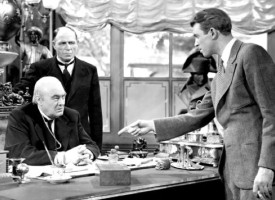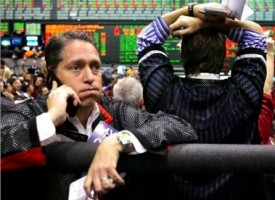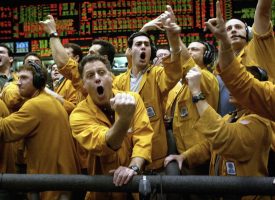On the heels of a historic election and chaos in global markets, the world is about to witness a breathtaking once in a century event.
Expect Stunning Changes
Stephen Leeb: “Donald Trump’s victory sparked some of the most tumultuous action in the markets in decades – by some measures far more extreme than in 2008….
IMPORTANT…
To find out which company is set to become one of the
highest grade producing gold mines on the planet
and is one of the greatest precious metals investment opportunities in the world
CLICK HERE OR BELOW:
There is little doubt the market is signaling major changes ahead. These will almost certainly be more than just a change in market leadership, from big-cap high-tech stocks to metal miners, etc. They will be more than a reversal in the market’s overall direction, say from bull to bear. Rather the market is telling us to expect stunning changes in the entire nature of the world’s economy. And all investors should be listening.

Trump Win Initially Shocks Global Markets
Let’s review this past historic week. On Tuesday night and early Wednesday morning as a Trump victory became ever clearer, stock futures dropped further and further into the red and at their low were down 5 percent. Gold rallied and at its high it was up about 5 percent.
Then it seemed to dawn on almost all investors at the same moment that whatever you thought about Trump’s temperament, his populist message had carried the day. His economic policies would be hell bent on growth. From climate change to financial regulation, all barriers to growth would be knocked down. And given his real estate background, leverage wouldn’t scare him one bit.
The thought of major infrastructure projects, tax cuts, less regulation, and a constrained Fed led to a 180-degree turn. Stocks were in, bonds and deflation out. Steady growth was out, leveraged cyclical growth was in. This was a trend that had been trying to take hold since mid-year, but the Trump victory sealed the deal big time.
Take a look at the chart below.
Year Chart Of Caterpillar, FaceBook, Amazon, Rio Tinto

Four major companies diverged dramatically post-election. Facebook and Amazon sank against the rising market, while Rio, one of the world’s largest commodity producers, and Caterpillar, which as the largest earth-moving company is highly leveraged to infrastructure and mining, soared. Most commodities followed suit. Copper’s weekly gain was one of the largest ever. And from its low in late October, when Trump started to gain in the polls, copper has climbed 15 percent.
Gold was the other side of the coin. After rising 5 percent on Tuesday evening and Wednesday morning, the Midas metal turned tail and finished the week down nearly 5 percent. Blame the decline, if you want, on the spike up in bond yields and the strong buck. But as I said above, the market’s dramatic moves signal a lot more than relatively short-term shifts in market leadership. For the record, gold almost always falls at the onset of major market turmoil as investors raise cash to get aboard the new leaders. And when the switch involves investors ditching deflation fears and replacing them with enthusiasm for growth, there’s further reason gold initially was left out in the cold.
 We Are About To Witness A Once In A Century Event
We Are About To Witness A Once In A Century Event
But don’t let that obscure the bigger reality. While gold could fall a bit more in coming days and weeks, the table has been set for the next act in a massive – perhaps once-in-a-century – bull market in the metal, as commodity scarcities force the world into a new monetary system with gold at its center.
America’s plans for infrastructure will likely be followed by similar efforts within the E.U., albeit no doubt reluctantly and with a lag. But the only way the E.U. can remain intact is if it starts to generate growth. Even if Merkel holds on to power, we think Europe will move in this direction, which means infrastructure spending. And if Merkel is defeated or doesn’t run, a big infrastructure push in Europe becomes an even bigger bet.
But even more to the point, however, is the massive amount the East will be spending on infrastructure. Such spending already has accounted for the uptrend in commodities even prior to the Trump blast-off.
Speaking of Europe, the biggest infrastructure project on that continent was the Marshall Plan, which after World War II helped build up the economies of war-torn countries, in the process granting the U.S. major trade partners. Many still speak with wonder at the scope of that plan. The Chinese analog, which I talk about a lot, goes by the name of One Belt, One Road (OBOR) or the Silk Road initiative. Whatever you call it, it is massive, by some estimates 12 times the size of the Marshall Plan. Its goal is to connect more than 60 countries, which together have 4.4 billion inhabitants and currently account for nearly 40 percent of the world’s economy. And OBOR is just the start of development in the East.
OBOR and the ongoing economic activity it will foster will utterly dwarf the impact China’s development already has had on the global economy. China today is the largest consumer of just about all major commodities. Multiply Chinese consumption today by many-fold and you get the long-term message of the past week’s unprecedented stock market turbulence.

With zigs and zags, for the foreseeable future the market will be trying to price in not just an ordinary bull market in commodities, one in which demand temporarily exceeds supplies, but a bull market powered by fundamental scarcities in basic commodities ranging from copper to zinc to fossil fuels. There will be a scramble for virtually all commodities, even ones that are relatively plentiful, as all will be needed to build out a world relying on new sources of energy. As I have argued before, once you have fundamental scarcities, it is probably too late to switch monetary systems from paper to gold. The time to switch is when these scarcities come into view. What we saw this week was the first sign that this new world is, indeed, within sight.
The $50 Trillion Project And A New Monetary Order
To give you a specific taste of what lies ahead, as the U.S. spends perhaps $1 trillion to repair its crumbling bridges, its ancient water pipes, its highways, and its electric grid, China will be adding 31 percent to its capacity to generate electricity as well as entering into agreements to build ultra-high-voltage grids (another area, along with super computers, in which China leads the world) that allow China to generate power it can transmit to countries ranging from Germany to Japan to India. This electricity will be needed to power electric cars and provide lighting in dense urban areas that have yet to be built. Wang Min, an executive vice president of the government-owned Chinese State Grid, has said ultra-high-voltage power networks can tie together the entire Silk Road by 2050. The cost estimate he gives is $50 trillion, well more than $1 trillion a year. But talking about this in dollars is misleading, indeed, meaningless.

As commodities grow scarcer, they won’t be available for dollars at all. Enter a new monetary order – and gold. I don’t expect to be around in 2050. But well before then, as signaled by the market this past week, we’re all likely to see Eastern development and the new gold-based monetary system it will spawn emerge as the dominant economic and socio-political stories for years to come.” ***KWN has now released the extraordinary KWN audio interview with whistleblower Andrew Maguire, where he discusses the gold and silver smash, at what price the large sovereign wholesale bids are located, and much more, and you can listen to it by CLICKING HERE OR ON THE IMAGE BELOW.
***ALSO JUST RELEASED: Whistleblower Andrew Maguire – This Is What The Commercials Banksters Are Up To In The Gold Market CLICK HERE.
© 2015 by King World News®. All Rights Reserved. This material may not be published, broadcast, rewritten, or redistributed. However, linking directly to the articles is permitted and encouraged.









